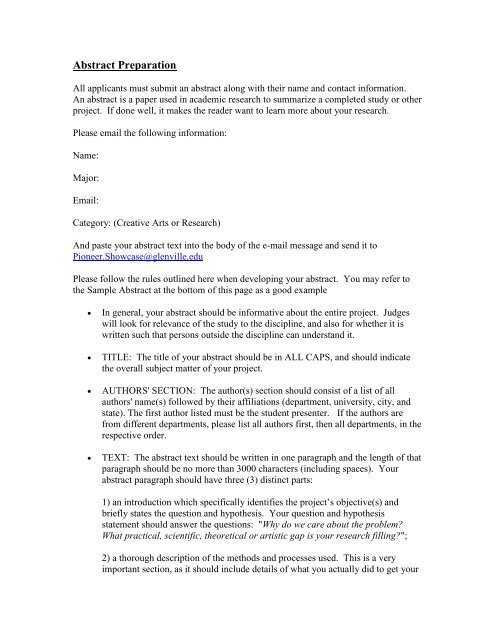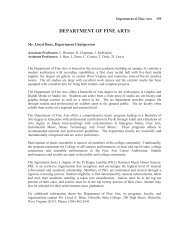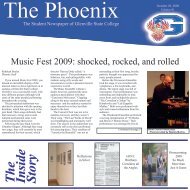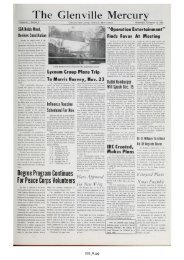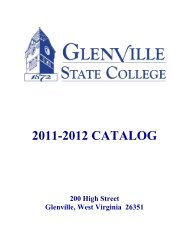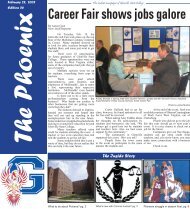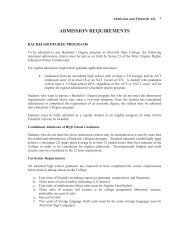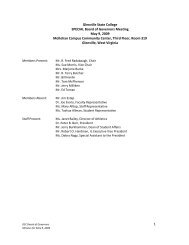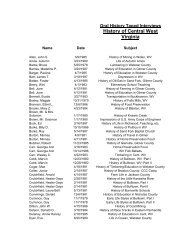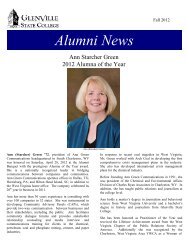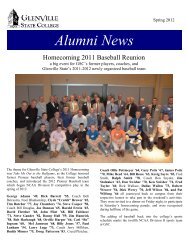Abstract Preparation - Glenville State College
Abstract Preparation - Glenville State College
Abstract Preparation - Glenville State College
Create successful ePaper yourself
Turn your PDF publications into a flip-book with our unique Google optimized e-Paper software.
<strong>Abstract</strong> <strong>Preparation</strong><br />
All applicants must submit an abstract along with their name and contact information.<br />
An abstract is a paper used in academic research to summarize a completed study or other<br />
project. If done well, it makes the reader want to learn more about your research.<br />
Please email the following information:<br />
Name:<br />
Major:<br />
Email:<br />
Category: (Creative Arts or Research)<br />
And paste your abstract text into the body of the e-mail message and send it to<br />
Pioneer.Showcase@glenville.edu<br />
Please follow the rules outlined here when developing your abstract. You may refer to<br />
the Sample <strong>Abstract</strong> at the bottom of this page as a good example<br />
<br />
<br />
<br />
<br />
In general, your abstract should be informative about the entire project. Judges<br />
will look for relevance of the study to the discipline, and also for whether it is<br />
written such that persons outside the discipline can understand it.<br />
TITLE: The title of your abstract should be in ALL CAPS, and should indicate<br />
the overall subject matter of your project.<br />
AUTHORS' SECTION: The author(s) section should consist of a list of all<br />
authors' name(s) followed by their affiliations (department, university, city, and<br />
state). The first author listed must be the student presenter. If the authors are<br />
from different departments, please list all authors first, then all departments, in the<br />
respective order.<br />
TEXT: The abstract text should be written in one paragraph and the length of that<br />
paragraph should be no more than 3000 characters (including spaces). Your<br />
abstract paragraph should have three (3) distinct parts:<br />
1) an introduction which specifically identifies the project’s objective(s) and<br />
briefly states the question and hypothesis. Your question and hypothesis<br />
statement should answer the questions: "Why do we care about the problem?<br />
What practical, scientific, theoretical or artistic gap is your research filling?";<br />
2) a thorough description of the methods and processes used. This is a very<br />
important section, as it should include details of what you actually did to get your
esults; and,<br />
3) a summary of the results and conclusions. You should NOT say "The results<br />
will be discussed". Instead, you should answer the question "As a result of<br />
completing the above procedure, what did you learn/invent/create?" Any<br />
conclusions drawn should explain the larger implications of your findings,<br />
especially for the problem/gap identified in the introduction. Judges will look to<br />
see if your conclusions tie back to the question.<br />
<br />
<br />
<br />
Limit your abstract text to approx. 500 words.<br />
Before pasting your abstract into an e-mail message, ensure that it is complete,<br />
accurate and error-free, as no changes will be allowed after the deadline date<br />
has passed. Once you've pasted it, make sure that it is complete and appears how<br />
you want it to appear in the Program Book.<br />
Submit your abstract before the deadline date, as no late submissions will be<br />
accepted, no exceptions<br />
Sample <strong>Abstract</strong>s:<br />
ZYMURGY…NOT JUST FOR DRUNKS: USING BEER TO STIMULATE<br />
INTEREST IN THE SCIENCE LABORATORY<br />
Westley Mullins, Adam Fischer, Joe Evans, and Gary Z. Morris Dept. of Science and<br />
Mathematics<br />
Have you ever had your students moan about how much they hate lab? How about<br />
rewarding their hard work with beer? Sound impractical? Not if beer brewing is your lab.<br />
Beer brewing is an activity that can be used to teach important biological, chemical, and<br />
biochemical processes taught in undergraduate microbiology, cell physiology,<br />
biochemistry, botany, and organic chemistry. Brewing is a fun activity that instructors<br />
will find retains the interest of the students, is simple, and can be designed to fit into<br />
several weekly lab periods. Brewing beer allows for the application of several chemical<br />
and biochemical assays to each step of the process including: tests for carbohydrates with<br />
Benedict's test and phenol-sulfuric acid assays; tests for protein using the biurets test and<br />
Bradford assay; and tests for alcohol content determined using a hydrometer and pocket<br />
refractometer. Analysis of “bitter ale” brewed by undergraduates at <strong>Glenville</strong> <strong>State</strong><br />
<strong>College</strong> using these techniques found that protein concentration increased from 0.15 to<br />
0.32 mg/mL from wart to bottle. It was also observed that the carbohydrate concentration<br />
decreased from 91.48 to 58.22 mg/mL from wort to bottle. Reducing sugar content also<br />
decreased from wart to bottle, while percent alcohol increased from 2.7 % at the end of<br />
the first week of fermentation to 4.0 % at the end of in-bottle aging. The most crucial test,<br />
tasting, was saved for after finals week and was a huge success. We are currently
comparing our previous results with new batches and using more techniques for<br />
comparison.<br />
ADVERTSING AND GRAPHIC DESIGN SEEKS TO INCREASE AWARENESS<br />
AND PARTICIPATION OF GLENVILLE STATE COLLEGE’S GLOBAL<br />
ENTREPRENUERSHIP WEEK 2010<br />
Justin Brown, Business<br />
The purpose of this project was to create awareness and increase participation among<br />
<strong>Glenville</strong> <strong>State</strong> <strong>College</strong> students during Global Entrepreneurship Week 2010. Students in<br />
Marketing 379 Advertising & Sales Promotion and Marketing 203 Graphic Design<br />
utilized a collaboration strategy to seek increased awareness and participation in Global<br />
Entrepreneurship Week events. Marketing 379 students created and executed a nonprobability<br />
Global Entrepreneurship Week survey of 125 <strong>Glenville</strong> <strong>State</strong> <strong>College</strong> students<br />
in a variety of majors, compiled and analyzed the findings using a simple excel<br />
spreadsheet. Findings indicated that students were not aware; 12% had never attended a<br />
Global Entrepreneurship Week event. Using results of the survey Marketing 379 students<br />
developed a creative brief strategy, the basis for Marketing 203 students’ advertising<br />
campaign. An entire class meeting was devoted to a collaborative assembly of both<br />
classes to discuss the strategy and execution of the project. Information from the creative<br />
brief was used by Marketing 203 students to develop the creative print materials for the<br />
advertising campaign. Advertising materials included a main poster that incorporated the<br />
overall schedule of events and individual posters that design changed but yet remained<br />
consistent from poster to poster. Sign-in sheets for each event quantified attendance.<br />
Results of the sign-in sheets showed an increased in attendance from the previous year.


